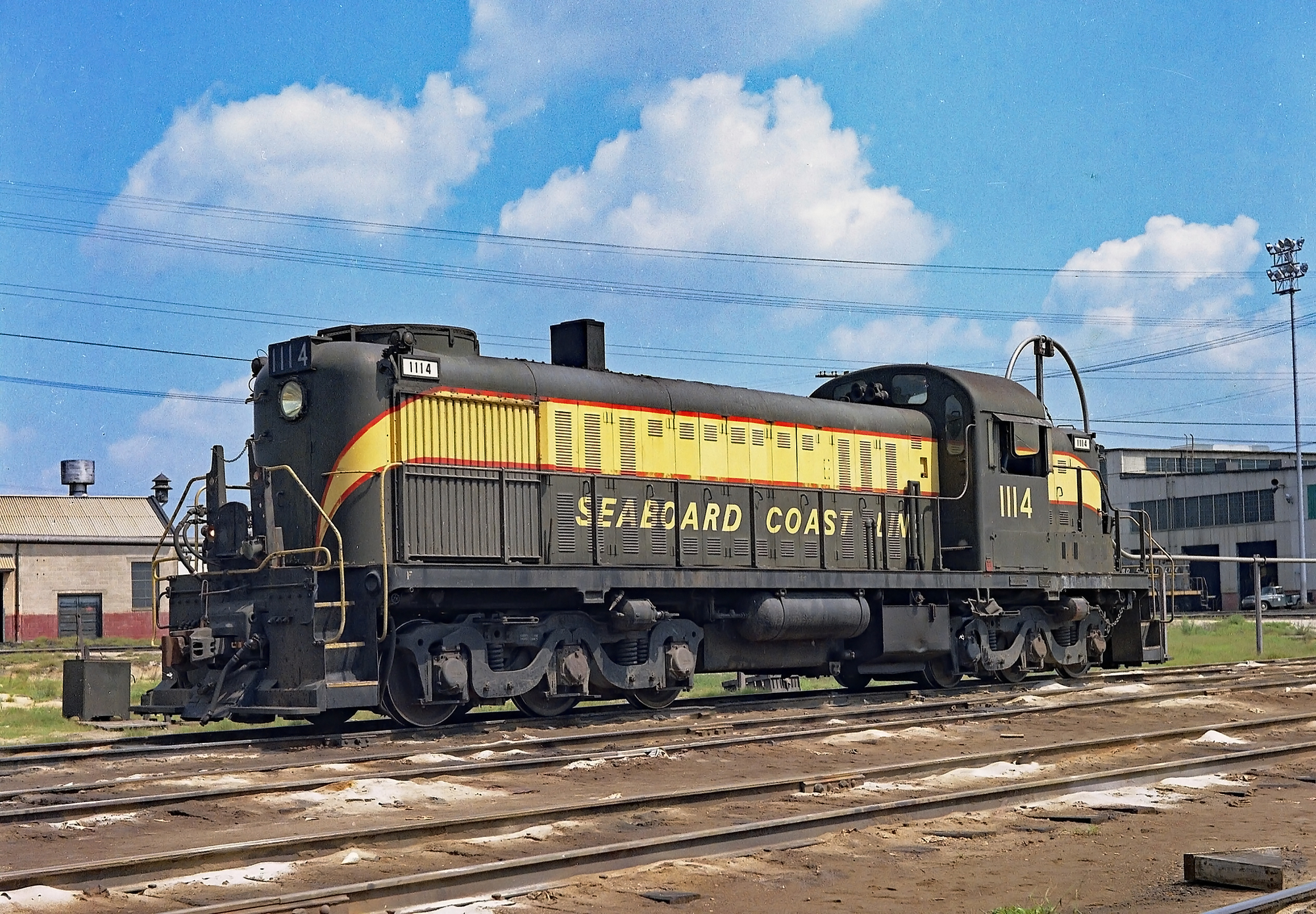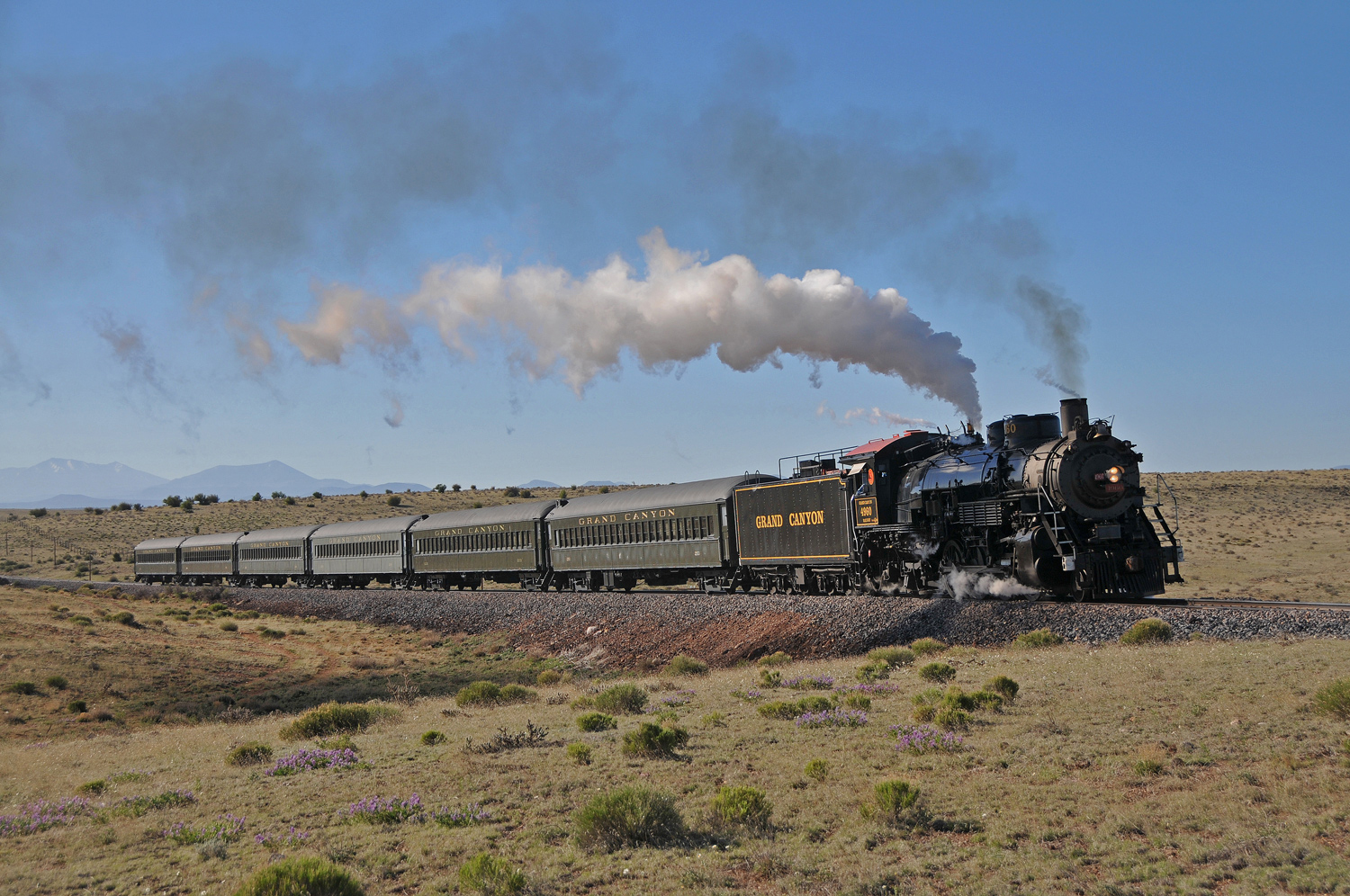Alco "RSC3" Locomotives: Data Sheet, Roster, Specs
Last revised: December 21, 2024
By: Adam Burns
Alco's RSC-3 was the builder's second A1A-A1A road-switcher intended for the light branch line service. It was based from the popular RS3 and followed the earlier RSC2.
While the builder's concept was sound, the A1A-A1A's unpowered center axle proved problematic due to its lower tractive effort rating; whereby an RS3's four powered axles could offer roughly 42,500 lbs, the RSC3's provided only 34,000 lbs.
In addition, its lack of redundancy as a specialized design intended made the RSC3 unattractive to most U.S. railroads. It ultimately sold better in Canada and to foreign lines with only the Soo and Seaboard Air Line acquiring examples.
 Seaboard Coast Line RSC3 #1114 was photographed here by Warren Calloway at Hamlet, North Carolina during the 1960s. This unit was built as Seaboard Air Line #1540.
Seaboard Coast Line RSC3 #1114 was photographed here by Warren Calloway at Hamlet, North Carolina during the 1960s. This unit was built as Seaboard Air Line #1540.Inception and Design
The RSC-3 emerged in the post-World War II era, a time characterized by rapid technological advances and an increasing demand for efficient transportation solutions.
First introduced in October 1950, the RSC-3 was Alco's followup A1A-A1A design to its earlier RSC-2.
The notable configuration was instrumental in distributing the locomotive's weight more evenly - with the center axle unpowered - which made it particularly suitable for routes with lighter rail or poor track conditions.
In his book, "The Diesel Builders, Volume II - American Locomotive Company and Montreal Locomotive Works," author John Kirkland notes the primary difference in the two models was the RSC-3's uprated GT581 traction generator.
Technical Specifications
The heart of the RSC-3 was Alco's 244, a robust powerplant with a 12-cylinder, 4-stroke design. The engine could produce 1600 horsepower.
The RSC-3 had a length of approximately 56 feet and weighed around 250,000 pounds. Its maximum speed depending on the three different gear ratios available for either passenger or freight service, ranging from 60-75 mph.
The first unit completed was Soo Line #372 in October, 1950 while Northwestern Railway of Pakistan acquired the final 17 examples completed in June, 1955.
| Entered Production | 10/1950 (Soo Line #372) |
| Years Produced | 10/1950-6/1955 |
| Model Specification | E1662/E1662A |
| Engine | 244, V-12 |
| Horsepower | 1,600) |
| Carbody Styling | Alco |
| Length (Between Coupler Pulling Faces) | 55' 11.75" |
| Weight | 250,000 Lbs. |
| Dynamic Brakes | Optional |
| Trucks | A1A-A1A |
| Truck Type | C-Type |
| Truck Wheelbase | 10' 6" |
| Wheel Size | 40" |
| Traction Motors | GE 726 (4): (Later upgraded to GE 752 [4].) |
| Traction Generator | GT581 |
| Steam Generator | Optional |
| Gear Ratio Options | 65:15, 74:18, 65:18 |
| Tractive Effort Rating | 34,000 lbs. at 13.5 MPH |
| Top Speed | 60 MPH (65:15), 65 MPH (74:18), 75 MPH (65:18) |
Production Roster
Alco
Total Built - 71
| Owner | Road Number(s) | Serial Number(s) | Date Built |
|---|---|---|---|
| Algerian Railways | DG1–DG5 | - | - | Caminhos de Ferro Portugueses | 1521-1525 | - | - | Consolidated Railways of Cuba | 1606-1611 | - | - |
| Ferrocarril Central del Uruguay | 1601-1603 | - | - |
| Minneapolis, St. Paul & Soo Ste. Marie (Soo Line) | 372-374 | 78298-78300 | 10/1950 |
| Northwestern Railway of Pakistan | 3301-3329 | - | - |
| Panama Railroad | 901–903 | - | - | São Paulo Railway (Brazil) | 550-561 | - | - |
| Seaboard Air Line | 1537-1540 | 78427-78430 | 11-12/1950 |
| Seaboard Air Line | 1541-1543 | 78539-78541 | 1/1951 |
| Wisconsin Central (Soo Line) | 2380 | 78894 | 6/1951 |
Montreal Locomotive Works
Total Built =28
| Owner | Road Number(s) | Serial Number(s) | Date Built |
|---|---|---|---|
| New South Wales Government Railways | 4001-4020 | - | - |
| Pacific Great Eastern | 561-566 | 76104-76109 | 5/1951-6/1951 |
| Pacific Great Eastern | 567-568 | 77698, 77699 | 5-1952-6/1952 |
Service and Operational Footprint
The market for early A1A-A1A road-switchers proved lukewarm at best. Only 91 units were produced in the RSC2 line, followed by 99 in the RSC3.
Domestic companies to acquire the latter included only the Soo Line (and subsidaries) along with the Seaboard Air Line.
The RSC-3 found more success internationally, where they proved indispensable for traversing rugged and often poorly maintained tracks.
Buyers included Algerian Railways, Consolidated Railways of Cuba, Caminhos de Ferro Portugueses, Ferrocarril Central del Uruguay, New South Wales Government Railways, Northwestern Railway of Pakistan, Panama Railroad, and São Paulo Railway
Preservation and Legacy
There are no surviving RSC-3 in the U.S. although a handful are preserved Australia, Brazil, Portugal, and Canada. Of note is Pacific Great Eastern #561 operating in Squamish, British Columbia at the West Coast Railway Heritage Park.
The Competitive Landscape
When the RSC-3 was introduced, the market for diesel locomotives was highly competitive, with major players such as Electro-Motive Division (EMD) of General Motors and Baldwin Locomotive Works vying for dominance.
The RSC-3's main competitor was EMD's GP7 - followed by the six-motored SD7. Both were versatile and powerful models. The GP7 was introduced in 1949 and quickly became popular due to its reliability, ease of maintenance, and redundancy in general freight service.
However, while the GP7 had a similar horsepower rating of 1500, the RSC-3 offered better performance on poor track conditions due to its six-axle configuration, compared to the GP7’s four-axle (B-B) setup.
Technological Evolution and Final Impact
As the 1960s progressed, advancements in locomotive technology led to the development of more powerful and efficient models. Alco itself continued to innovate, producing successors like the RS-11 and the more powerful C-420.
With the RSC-3's lack of success, Alco closed the book on A1A-A1A models domestically, pivoting to either six-motored (C-C) designs or its standard four-axle variants.
The A1A-A1A design fell out of favor largely due to the 100-ton freight car, which found widespread use during the 1950s. This car allowed railroads to handle heavier trains and was embargoed on lighter trackage with axle loadings less than 60,000 lbs.
In any event, the RSC-3 remained a pivotal product in Alco's portfolio, serving as a bridge between the early diesel era and more advanced locomotive technologies.
Its impact extended beyond its immediate operational life. It set standards for build quality, versatility, and robustness, influencing subsequent locomotive designs.
Crucially, it demonstrated the viability of diesel power in varied and challenging environments, thereby accelerating the broader adoption of diesel-electric technology in the railroad industry.
Conclusion
The Alco RSC-3 diesel locomotive remains an iconic piece of railway history. Its innovative design, reliability, and versatility ensured its widespread use and left an enduring legacy in both North American and international railroading.
From its conception in the bustling industrial age of post-war America to its celebrated status in railway museums today, the RSC-3 stands as a monument to the ingenuity and progress of the locomotive industry.
Whether remembered through the lens of technological achievement or operational excellence, the RSC-3 is a locomotive that well and truly earned its place in the annals of railroad history.
Recent Articles
-
Florida Railroad Museums: A Complete Guide
Apr 17, 25 04:48 PM
Florida is home to many railroad museums preserving the state's rail heritage, including an organization detailing the great Overseas Railroad. -
Delaware Railroad Museums: A Complete Guide
Apr 17, 25 04:23 PM
Delaware may rank 49th in state size but has a long history with trains. Today, a few museums dot the region. -
Arizona Railroad Museums: A Complete Guide
Apr 16, 25 01:17 PM
Learn about Arizona's rich history with railroads at one of several museums scattered throughout the state. More information about these organizations may be found here.
